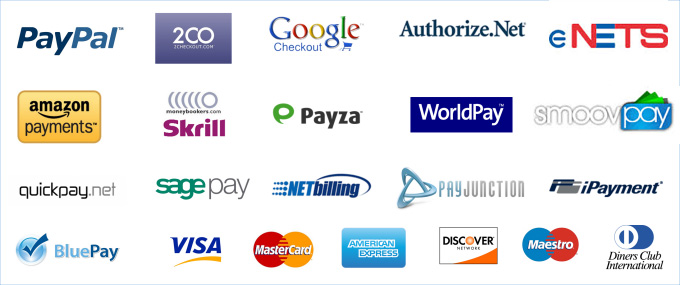Internet Solutions - eCommerce Deployments
As one of the leading developers in Singapore, we have successfully
implemented many e-commerce projects with credit card payments.
We offer a variety of e-commerce solutions that we can tailor to your needs. Our
team specializes in Customized eCommerce CMS, Opencart, Oscommerce, Magento,
VirtueMart, Prestashop, CS-Cart and Shopify among many others.
We work closely with clients on the process of online business, kindly do read
the Essential Elements of Building an E-commerce website..Are you ready ? Not
sure ? Talk to us and we will advise you
We work with Paypal, 2Checkout, Smoothpay , Worldpay and many other payment gateway providers
Some of our E-Commerce Deployments
http://laurentbernard.com.sg
(OpenCart)
http://sttstraining.com/store (
OpenCart - Converted from OsCommerce )
http://shop.wine-universe.com.sg
( Open Cart )
http://insectkillers.com.sg ( OpenCart
)
http://www.zhai.com.sg ( WooCommerce )
http://www.wineexchangeasia.com
( ZenCart )
http://www.gcasiadental.com (
OpenCart)
The Essential Elements of Building an E-Commerce Website
If you plan to sell anything online, having an e-commerce plan is as important as your original business plan.
The first step in writing an e-business plan is to decide what kind of experience you want your online customers to have. Think not only about today but also two and five years down the road.
Your e-commerce plans starts with website goals. Who are your target customers? What do they need? Are they getting information only, or can they buy products at your site? These key questions, asked and answered early, will determine how much time and money you'll need to develop and maintain an online presence.
Second, decide what products or services you will offer. How will you position and display them? Will you offer both online and offline purchasing? How will you handle shipping and returns?
Additionally, don't overlook the customer's need to reach a live person. A toll-free phone number should be prominently displayed that customers can call anytime to get their questions answered by a live person.
If you decide to sell online, you'll need a shopping cart component, which is a means of handling credit card processing, and an organized order fulfillment process.
Finally, even if you build an amazing website, don't assume people will find you on their own. If you want to develop a consistent flow of traffic to your site, it's essential that you plan and maintain an ongoing and multifaceted promotional strategy that's carefully targeted to your audience.
Once you've decided to have a website, one of your first 'to-do' items is to make a list of possible website names or URLs.
Then run, don't walk, to the nearest computer, log on to the internet, go to your favorite search engine, and type in "domain registration." You will find a list of companies, such as networksolutions.com, godaddy.com and register.com, that will guide you through the simple domain registration process.
For a modest fee ($8 to $75), you can register a domain name for one or more years.
From the available names, choose one that's easy to spell and remember, and describes what your company does. Make sure, however, you're not imposing on someone else's trademark or copyrighted name. In many cases, the name of your company, with the addition of dot-com (www.[YourCompanyName].com) is a suitable domain name that you should definitely register.
Once you've registered your domain name and have a plan in place for what you want to offer prospective and existing customers online, the next major challenge is designing and building your actual website and online presence.
What makes a good website? Before getting enmeshed in design details get the big picture by writing a site outline. The content you develop and publish should directly relate to and help you achieve the goals and objectives you've set for the website.
A well-thought-out site outline includes:
Content. The key to a successful site is content. Give site visitors lots of interesting information, incentives to visit and buy, and ways to contact you. Once your site is up and running, continually update and add fresh content to keep people coming back.
Structure. Decide how many pages to have and how they'll be linked to each other. Choose graphics and icons that enhance the content.
Design. With the content and structure in place, site design comes next. Whether you're using an outside designer or doing it yourself, concentrate on simplicity, readability and consistency. Remember to focus on what you want to accomplish.
Navigation. Make it easy and enjoyable for visitors to browse the site. For example, use no more than two or three links to major areas and never leave visitors at a dead end.
Credibility. This is an issue that shouldn't be lost in the bells and whistles of establishing a website. Your site should reach out to every visitor, telling that person why he or she should buy your product or your service. It should look very professional, and give potential customers the same feeling of confidence they would get with a phone call or face-to-face visit with you. Remind visitors that you don't exist only in cyberspace. Your company's full contact information -- company name, complete address, telephone, fax and e-mail -- should appear on all or most of your individual web pages and be displayed prominently on your site's home page.
An outline helps you get the most out of your website design/e-commerce budget. It will also help you determine whether you, or someone in your company, can design portions of the website, or if you need to solicit outside help. That way, when you hire someone, it will be for only the parts of the job that you'll need to have outsourced.
[ Return to Top ]

